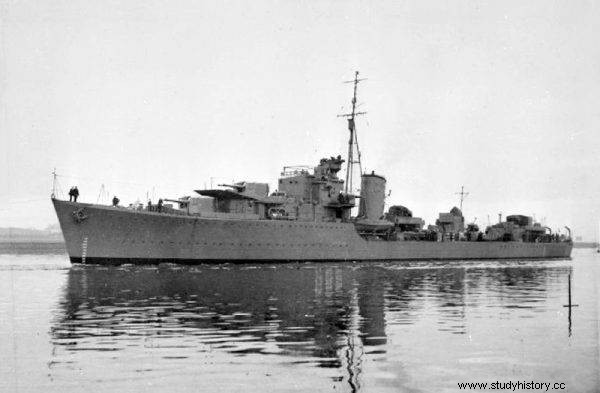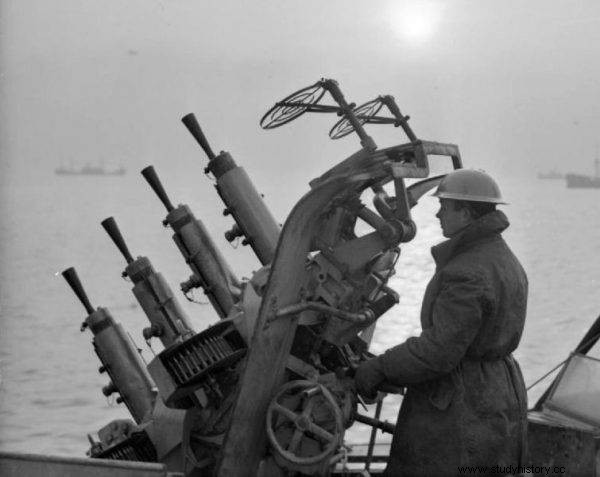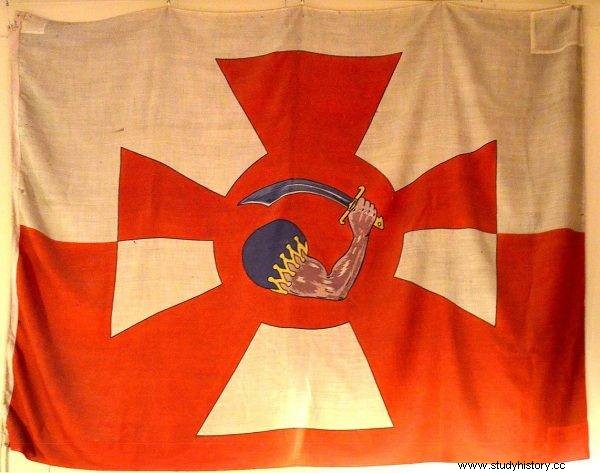The roar of an explosion tearing the sky apart. A feast of colors of incoming missiles. Sailors jumping into the water in a frantic escape from a burning ship. Commanders 'cold blood, soldiers' bravery. Deadly fight and only two options:doom or victory.
Night of June 13-14, 1944. Fighting continues in Normandy. Polish destroyer ORP "Piorun" is on patrol in the Saint-Malo Bay area. He is accompanied by the British destroyer HMS Ashanti. Unexpectedly, the radars of both ships target a squadron of large German minesweepers. There is a violent fight the outcome of which is by no means a foregone conclusion in favor of the Allied ships…
Allied patrol
Piorun and Ashanti set out to sea from Plymouth base in the late afternoon of June 13, 1944. The commander of the Polish ship and at the same time this small Allied formation was Lieutenant Commander Tadeusz Gorazdowski. The orders for the destroyers were as follows:
Patrol off the coast of France in the Roches Douvres lighthouse area. Destroy everything that floats . There are signs that the enemy will want to evacuate from Cherbourg by sea to Saint-Malo…
The basin to which both Allied ships were heading, near the island of Jersey, was quite difficult in terms of navigation. Strewn with dozens of small islands that were great shelters for German torpedo boats often operating in this area. You had to be very careful.
I am bored on the radar!
On the approach to Roches Douvres, a combat alert was announced on the destroyers before midnight June 13, so that, in the event of a surprise, the crews are immediately ready to fight. Foresight paid off. Several minutes after midnight, three pulsating lights appeared on the radar screen on ORP "Piorun". There was no doubt about it:Germany! The Poles just did not know how strong the opponent will be.
Lieutenant Commander Gorazdowski immediately ordered that the "Ashanti" commander, Lieutenant Commander Barnes, be informed about the situation. It turned out that the British had also located the enemy . The Polish commander ordered the speed of both ships to be increased.

ORP "Piorun" (source:public domain).
Allied destroyers at a speed of 25 knots crossed the course of the German squadron. The three "Piorun" artillery towers, each holding two 120mm guns, in the darkness turned towards the approaching enemy, ready to spit fire at any moment .
Interestingly, the Germans were probably completely unaware of the presence of Allied ships. This was evidenced by the fact that their units did not change course and speed even one iota. Meanwhile, both allied destroyers were zooming in close to use, in addition to the main artillery, also smaller, shorter-range cannons.
Night Battle
The German ships were already visible to the naked eye when the artillery officer of "Pioruna", Lieutenant Jerzy Tumaniszwili, commanded: Continuous fire with salvo shots! Fire! The distance between the units of both sides was just over three thousand meters. It was 12:38 a.m. on June 14, 1944.
To the surprise of Polish and British sailors, in the light of the illuminating missiles it turned out that there were as many as seven enemy units! And worse, the firepower of the German squadron was equal to the firepower of both destroyers!
The opponent of "Piorun" and "Ashanti" turned out to be large German M-1 minesweepers from 24 fleet of minesweepers. Each of them was armed with two 105mm cannons and lighter anti-aircraft guns. Both destroyers had a total of 14 120-millimeter guns. The Allied ships were twice as fast as the German ones, but in the area dotted with rocky islets and numerous shallows, they could not take full advantage of their advantages.
The destroyers concentrated their fire on the ship leading the German squadron. After a few volleys from the deck of the enemy minesweeper, fire and clouds of smoke burst out . Piorun and Ashanti then fired on the second German unit.
"Lightning" in trouble
However, the remaining German ships, so far undisturbed, were not idle either and responded with strong, and even worse, effective fire. A series of enemy missiles streaked towards the destroyers. Lieutenant Tumanishvili reported:
Green, red and yellow. More and more missiles were getting closer, and they were approaching very fast. And when they passed over the ship, they hissed, howled, meowed, and a terrible noise arose around the ship. Some buzzing, crackling, whistling, clinking and giggling took our possession. They seemed to fly from all sides, and the ship from the highlands of our rangefinder looked as if wrapped in green and red garlands.
At one point, a large-caliber German shell hit the ammunition park at the stern gun directly. A fire broke out, an ammunition man, sailor Żuczek, was injured. The situation was extremely dangerous. In the event of an explosion of the ammunition stored there, "Piorun" could even be threatened with destruction! The tragedy was avoided thanks to the dedicated action of the gun crew, which, before the emergency team with fire extinguishers arrived at the scene, threw the burning shells overboard with their bare hands .

Machine guns aboard HMS Ashanti
Another missile burst at the anti-aircraft mount of the stern Oerlikon. Two sailors were injured. Thanks to the immediate reaction of the ship's deputy commander, Captain Wienczysław Kon, the rescue team quickly evacuated the wounded to the field hospital.
Great success of the Allied ships
Despite these difficulties, Piorun continued to fight. At some point, our destroyer was in a convenient position to launch torpedoes. The commander immediately took advantage of this and ordered the head of the torpedo department, Lieutenant Leopold Kawernyński to conduct a torpedo attack.
"Maślak", as everyone called him, did a great job. Several dozen seconds after the torpedo salvo was launched at the side of one of the German minesweepers, a blinding flash was noticed . The violent shock that accompanied it was felt even by Polish sailors on board the "Piorun". It was evident how German sailors were escaping from a torpedoed, sinking minesweeper.
At this stage of the fight, the German team broke up. Two minesweepers were sinking and at least three more were on fire. The Germans began to retreat from the battlefield . The destroyers, however, did not let go. During the pursuit, they inadvertently came within range of the Jersey Coastal Cannons. The sea around "Piorun" and "Ashanti" boiled from heavy missiles explosions . Both ships started maneuvering to leave the dangerous area.

The bow pennant ORP "Piorun" stored at the exhibition at the Polish Army Museum in Warsaw (author:Tebeuszek, license:CC BY-SA 4.0).
Eventually, the remnants of the German squadron escaped to the port of Saint-Malo. The victory of the allied destroyers was indisputable . At least three German minesweepers were sunk, and of the others, at least another three were badly damaged because they burned to the end of the battle. The last German ship was also classified as damaged. Both Allied destroyers are considered to be the perpetrators of the destruction of German minesweepers.
On the morning of June 14, ORP "Piorun" and HMS "Ashanti" entered the port of Plymouth at a gala flag as a sign of victory, amid the applause of the seamen from the ships mooring there. On May 3, 1945, Lieutenant Commander Tadeusz Gorazdowski and Lieutenant Jerzy Tumaniszwili were awarded the Silver Cross of the War Order of Virtuti Militari V class in recognition of their merits for the Battle of Jersey .
The same decoration for bravery in saving the ammunition park was given to boatswain Józef Wojciechowski. Another thirty-four officers, non-commissioned officers and sailors received the Crosses of Valor for the operation on the night of June 13/14, 1944.
